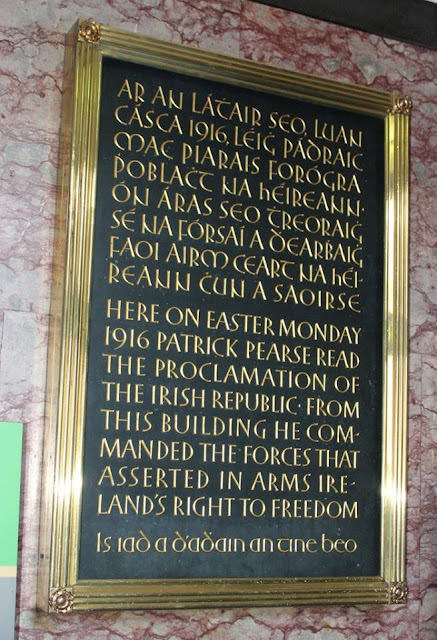Exactly 100 years ago the streets
of Dublin and skirmishes in counties Meath, Louth, Galway and Wexford saw much turmoil and bloodshed during an armed
insurrection, mounted by Irish republicans to end British rule in Ireland and
establish an independent Irish Republic.
Every year at Easter, this event
is remembered. All the more at Easter 2016 – the year which marked the
centenary of the defining moments of the struggle for independence.
There
was a military parade, including an Aer Corps flypast and a 21-gun salute. There
were synchronised wreath-laying
ceremonies at strategic points around Dublin Dublin Castle Garden of Remembrance
Internationally,
centenary events also took place in 100 countries, including one at the John F Kennedy Center Washington , DC Nigeria
I am not a historian but because
of a natural interest in the affairs of the land, I have been collecting
reprints of first hand accounts of the 1916 Easter Rising. These took the form
of memorabilia or newspapers from Northern
Ireland , the Republic
of Ireland United
States .
It was interesting to note that
the very same event was interpreted differently by the different publishing
houses. Their perspectives were very much coloured by where their sympathies
lay.
The Easter Rising of 1916 is now widely
regarded with pride. Patrick Henry Pearse was seen as the embodiment of
the rebellion, and he was executed alongside 15 other leaders.
Those who were executed were venerated by many as martyrs; their graves in Dublin
This insurrection also provided
fodder for great literary works, some of which are O’Connell Street" and "Lament
for the Poets of 1916" by Francis Ledwidge, ‘The Plough and the
Stars’, a play by Sean O’Casey, and ‘Insurrection’ by Liam O’Flaherty.
Although the flame of Irish
nationalism had begun to burn, some questions remain:
Was it justified as fighting for freedom or a futile
battle? Who were the heroes and who were the villains? Could the 1250
insurgents in Dublin fight the
16000 troops and 1000 armed police in Dublin ?
Did the countless civilians have to die for an insurrection that they were not
part of? Was it idealism at its best or a gross act of miscalculation?
Looking back, it feels surreal
that people, male and female, from all walks of life would give up their lives
for the greater good.
I wonder in this 21st
century how many of us will actually do that. And even if the young people had
wanted to involve themselves in the fight for liberty, equality and fraternity,
would their parents have allowed them? Or would they say – get your degree, get
a job and put these idealistic notions out of your head!
I wonder too whether present day
netizens would subscribe to a larger cause, rather than spend copious amounts
of time taking selfies and checking feeds on facebook.
I wonder too, how those who fought
in 1916 would judge us and our society today.






No comments:
Post a Comment